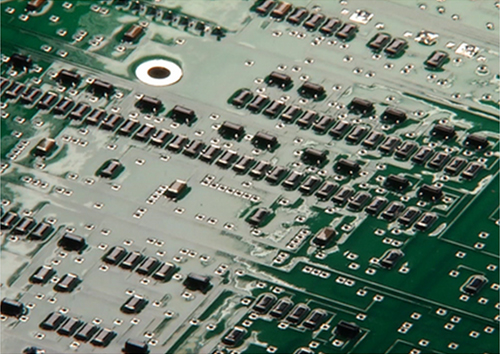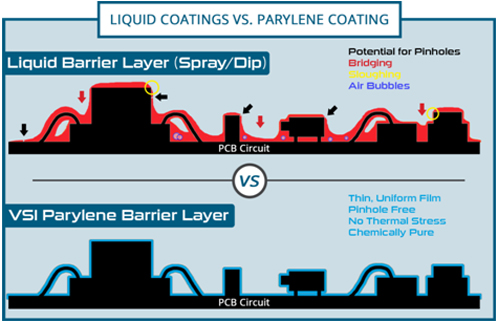
Moisture Protection/Electronic Enclosures
A common problem is often junction box panels with PCB assemblies which end up being
exposed to condensation due to the sealed enclosure, and temperature/humidity issues.
If the condensation is great enough, it drips onto the electronics from the inside
of the enclosure causing corrosion or electrical shorts.
Several options can be considered to prevent / eliminate such damage.
Traditional conformal coatings are a common surface treatment proving limited protection
from corrosion and electrical shorts. While they are not designed to protect boards
from large water drops or condensing moister, they do keep water drops off the board
for short periods of time (~10 minutes). Any longer and water may permeate the coating.
This is the least expensive and most common, but also offers the lease effective
water protection. However, if all you are concerned about is non-condensing humidity
it may be a good solution.
 Newer conformal coatings are the vapor deposition or nano-coating types. Often cell
phone manufacturers use these types of coatings because they can get between ultra
tiny parts. They can be very inexpensive for very high volumes (>1 million per year)
of small boards. They require special handling of the boards afterwards since the
coating is easily damaged.
Newer conformal coatings are the vapor deposition or nano-coating types. Often cell
phone manufacturers use these types of coatings because they can get between ultra
tiny parts. They can be very inexpensive for very high volumes (>1 million per year)
of small boards. They require special handling of the boards afterwards since the
coating is easily damaged.
The next level of protection may be encapsulants, such as potting compounds, epoxy
resins, etc. They can be applied over just one component, one entire side of the
printed circuit board assembly or over the entire board. This is basically a plastic waterproof covering.
It’s common for small, inexpensive devices, which must survive very wet environments,
to be entirely submerged (potted). Sometimes only one side of the board is coated
like a more robust traditional conformal coating. Keep in mind though that the bare
PCB substrate is glass fiber and absorbs moisture. So if the environment is humid,
over time the water will be able to corrode the traces from the inside unless the
entire board is protected.

These materials have a range of properties (such as hardness, thermal expansion, etc.). This work well for low and high volume applications and may be inexpensive
if the required volume is low and easy to apply.
For many automotive applications, the PCB assembly is placed in a waterproof enclosure
and filled with a soft potting compound. This not only provides two layers of protection,
but prevents damage caused by temperature swings creating large pressure differentials
in the unused air space.
If your enclosure is too large to fill with an encapsulant, but is water tight,
it’s important to allow for these pressure changes by using a pressure relief valve
to prevent moisture from condensing.